Is a Pin or Pinless Moisture Meter Best for You?
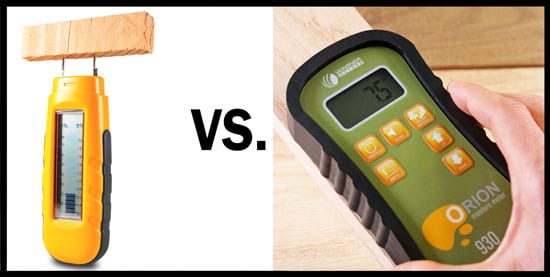 Dear pin moisture meter user,
Dear pin moisture meter user,
For years now, you’ve been asking us questions about pinless moisture meters. We get these questions at trade shows, over the phone, via email—questions about how (and whether) you can easily and quickly use a pinless moisture meter to accurately measure the moisture content of wood.
Questions like these:
- What’s the difference between a pinless meter and a pin meter?
- Do pinless meters need to be calibrated like pin meters?
- Are pinless meters affected by the temperature of the wood?
- Are pinless meters affected by the orientation of the wood?
- How do you take a reading with a pinless meter?
This guide is going to answer all these questions in detail. We’re also going to talk about different types of woodworkers and what they look for in a moisture meter. This will help you determine if a pinless meter will work for you.
What’s the difference between a pinless meter and a pin meter?
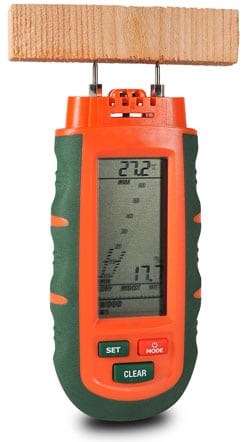 Pin moisture meters determine a wood’s moisture content by measuring the resistance encountered by an electrical current running between a couple of small pins that are inserted into the wood.
Pin moisture meters determine a wood’s moisture content by measuring the resistance encountered by an electrical current running between a couple of small pins that are inserted into the wood.
This method works because water with salts and impurities conducts electricity and wood doesn’t. The drier the wood, the more resistance to the electrical current.
Because pin moisture meters are sensitive to variations in temperature, they almost always come with correction charts.
Pin moisture meters are also sensitive to the chemical makeup of the wood. Since this varies from species to species, quality pin moisture meters will ask you to input the type of wood before taking a reading.
Pinless moisture meters measure a wood’s moisture level using electromagnetic sensors to scan the wood. Since they don’t poke holes in the wood, they’re good for measuring the moisture level in wood used for expensive hardwood floors and fine furniture.
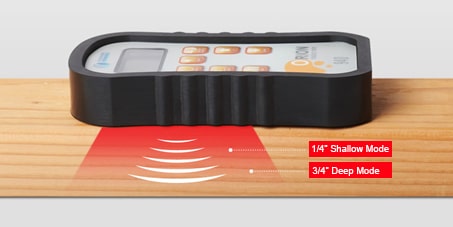
Some pinless moisture meters aren’t sensitive to temperature variations (provided they’re not extreme) or wood’s chemical makeup. However, they are sensitive to variations in wood density (also referred to as specific gravity). Because different types of wood have different densities, users will need to make sure the meter is set to the correct specific gravity setting before taking measurements.
Do pinless meters need to be calibrated like pin meters?
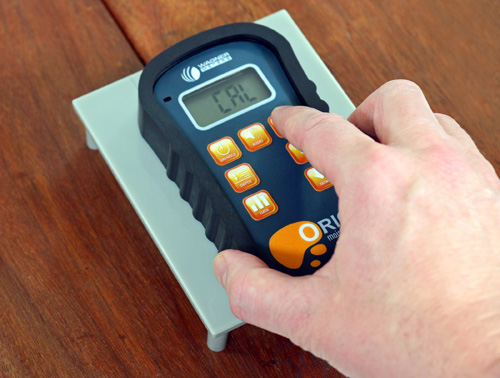 Yes, even the best moisture meters won’t be able to provide accurate measurements if they’re not properly calibrated. While the manufacturers of pin moisture meters offer calibration blocks that allow you to determine if your pin meter is in or out of calibration, you will still need to send it back to the manufacturer if you want it recalibrated. That means downtime.
Yes, even the best moisture meters won’t be able to provide accurate measurements if they’re not properly calibrated. While the manufacturers of pin moisture meters offer calibration blocks that allow you to determine if your pin meter is in or out of calibration, you will still need to send it back to the manufacturer if you want it recalibrated. That means downtime.
There is no model of pin meter that can be recalibrated onsite.
However, Wagner’s Orion® series of pinless meters come with an on-demand calibrator that allows you to recalibrate the meter back to factory settings yourself, in the field, in about 30 seconds.
Are pinless meters affected by the temperature of the wood?
Some pinless meters are affected by the temperature of the wood. Wagner meters, however, are virtually unaffected by wood temperature except in extreme cases. For example, wood that is frozen solid will affect the accuracy of the reading taken will every single pinless meter on the market today, including a Wagner meter.
Are pinless meters affected by the orientation of the wood?
Yes, some pinless meters are affected by the angle of the grain.
How do you take a reading with a pinless meter?
Taking moisture readings with a pinless meter is as easy as turning on the meter, entering the specific gravity for the wood species you’re measuring, and then placing the meter on the wood.
Pinless meters allow you to conduct as many moisture tests as you want without ruining the wood. Just pick the meter up, set it down in another spot, and take a new reading. You can easily take multiple readings with a pinless meter in the time it takes to perform just one reading with a pin meter.
Pinless meters do much more than just measure the moisture content of wood
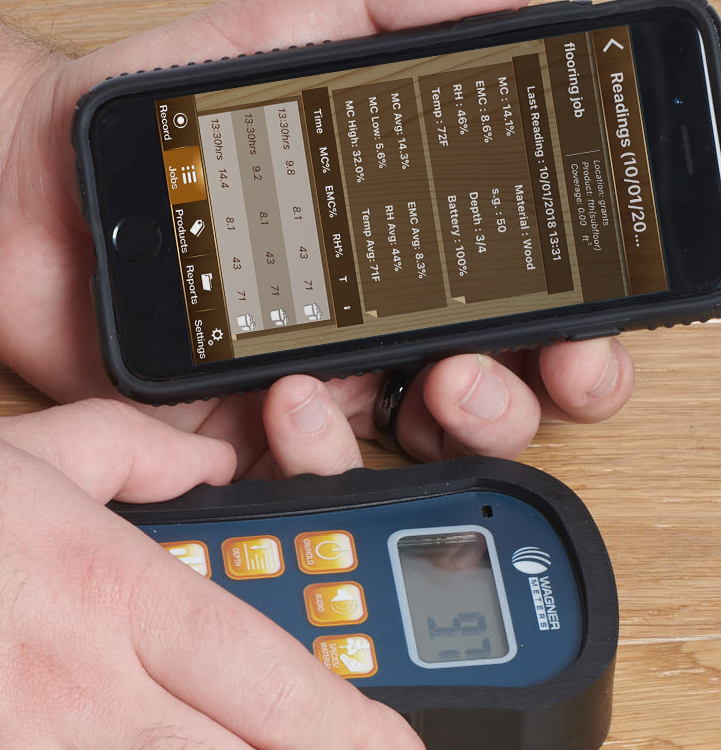 As we noted above, moisture measurement technology hasn’t significantly changed in the past 20 years. So, advanced features are one way you tell a high-end pinless moisture meter from the inexpensive, low-end varieties.
As we noted above, moisture measurement technology hasn’t significantly changed in the past 20 years. So, advanced features are one way you tell a high-end pinless moisture meter from the inexpensive, low-end varieties.
High-end pinless moisture meters today are able to do things like calculate the EMC for you, store measurement data, and easily recalibrate on-site.
The two main advantages of pinless meters
They don’t damage the wood.
Pin-type moisture meters are not ideal if you’re measuring the moisture content of fine furniture or hardwood floors. Unless you’re reading the moisture content of a very small piece of wood, you’ll need to take more than one reading and poke more than two holes in the wood. This is because pin moisture meters only measure the moisture level between the two pins.
You can quickly take multiple readings.
A pinless meter can quickly take multiple readings in the same time it takes a pin meter to take just one reading. And all without damaging the wood. This is especially valuable when you need to take readings on a large batch of wood, for example, a truckload.
Why you might want to stick with a pin meter
For accuracy, pinless meters need full contact with the surface of the material being measured. Therefore, if the material has a rough surface (firewood, for example), a pinless meter isn’t the best choice. Pin meters, on the other hand, are excellent for measuring the moisture content of wood that has an uneven surface.
Another reason you might want to use a pin meter is if you need to know how the moisture is distributed in the wood. Pinless meters give you the average moisture reading in the area scanned. While this is certainly valuable information, there are times when you might want to know how the moisture is distributed throughout the wood. For example, if you’re curing wood, you might want to know how the process is progressing. In order to do this, you can use a pin meter to easily take moisture readings at various depths.
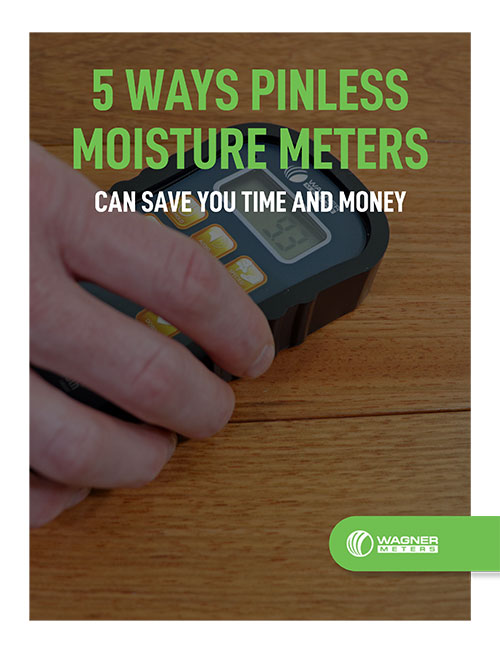
Free Download – 5 Ways Pinless Moisture Meters Save You Time and Money
Which type of moisture meter is best for you?
Hobbyist Woodworkers
If you’re a hobbyist woodworker, you probably didn’t pay attention to wood moisture levels until you had your first problem related to moisture. In fact, maybe you didn’t even realize that you needed to use a moisture meter.
If you’re on a tight budget and just want the bare minimum, you can start off with a less expensive meter and then upgrade later. If you’re concerned about accuracy, you should start off with a high-end meter. Things to consider include…
What kind of end products are you creating? Do you care if you poke holes in them? Is it important to measure the EMC of the location where they’ll be placed? If so, you’ll need a meter that can measure the EMC.
You’ll also need to think about how dedicated you are to your craft and the amount of disposable income you have to spend on it. If there’s a chance you might end up as a semi-professional woodworker, you should think about getting a higher-end meter.
Recommendation: Pin or pinless meter, but not necessarily high-end if just starting out.
Firewood users
Pinless meters need a flat surface. Therefore, if you’re only going to be measuring the moisture content of firewood, a pin meter is the way to go. Even an inexpensive one that’s off by 5-7% will probably do the job.
Recommendation: Inexpensive pin meter
Professional-level woodworkers
Professional-level woodworkers make furniture as well as accessories like cutting boards, shelves, picture frames, and various arts and crafts. They need a highly accurate moisture meter because when people buy furniture from a pro woodworker, they expect it to last. They are looking for heirloom quality, not something they can find from a big-box store.
Of course, if you’re a professional level woodworker, you obviously don’t want to be poking holes in the wood. Also, you’ll want to take enough moisture readings so that you get a good overview of the wood’s moisture content. If you’re using a pin meter and you’re working with dense wood, this might feel like it’s too much work. In other words, you might get lazy and end up not taking the proper number of readings. Pinless meters enable you to easily and quickly take multiple readings on every board. This will help you find the outliers, which are always there.
Recommendation: High-end pinless meter
Carpenters
Carpenters do a little bit of everything including stairs, countertops, shelves, etc.
For them, accuracy and ease of use are very important. They also probably don’t want holes in the wood.
Recommendation: Probably a pinless meter. However, it really depends on what you’re building.
Cabinet or Millwork Shops
Cabinet or millwork shops have basically the same requirements as professional-level woodworkers. Accurate moisture readings are important, and they don’t want to poke holes in the wood.
Keeping track of and storing data is also important though. If you’re using a meter that can store data and then print it out in the form of a report, you can provide proof to customers that any problem with a cabinet or millwork isn’t because of something going on in your shop. You’ll be able to print it out and say, “As you can see, I measured the batch. Therefore, the problem with the door not fitting right anymore must be related to a problem in your house.”
Recommendation: High-end pinless meter
Furniture Manufacturers
The requirements of furniture manufacturers are similar to those of cabinet or millwork shops. They care about accuracy, ease-of-use, storing data, and being able to take readings without damaging the wood. Because furniture manufacturers are big operations, they also care about being able to quickly take moisture readings. Price isn’t usually an issue.
Recommendation: High-end pinless meter
Luthiers
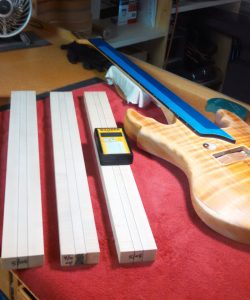
Luthiers make musical instruments, both big and small. Their main concern is to avoid damaging the wood. If they’re a large manufacturer, they’re also concerned about data storage. The ability to take dual-depth readings is important because the wood used to make musical instruments gets thinned during the construction process. Therefore, they need a meter that can take accurate readings on a variety of wood thicknesses.
Recommendation: High-end pinless meter
Small Sawmill Operators
When it comes to moisture readings, small sawmill operators care about speed. They want to be able to take multiple readings easily and quickly. They need to know how dry their wood is because that’s what they sell—dry wood. So, they need to be able to quickly and accurately measure large quantities of wood—every single piece. Data storage is important because they need to create reports and track specific batches over time. They need to be able to show these reports to customers.
If the wood is rough, they’ll need a pin meter. However, most saws aren’t too rough for pinless meters.
Recommendation: High-end pinless meter, unless the wood is rough.
Is It Time to Make a Switch?
Even if you have been using pin-type moisture meters for years, now may be the time to consider switching to pinless meters. They’re fast, accurate, easy to use, and suitable for a wide variety of applications. For more information about the best moisture meter for your situation, call Wagner Meters worldwide toll-free at (541) 291-5124.
Consider reading our Pin vs Pinless moisture meter guide next.
As Sales Manager for Wagner Meters, Ron has more than 35 years of experience with instrumentation and measurement systems in different industries. In previous positions, he has served as Regional Sales Manager, Product and Projects Manager, and Sales Manager for manufacturers involved in measurement instrumentation.
Related Posts via Taxonomies
Last updated on June 29th, 2022



